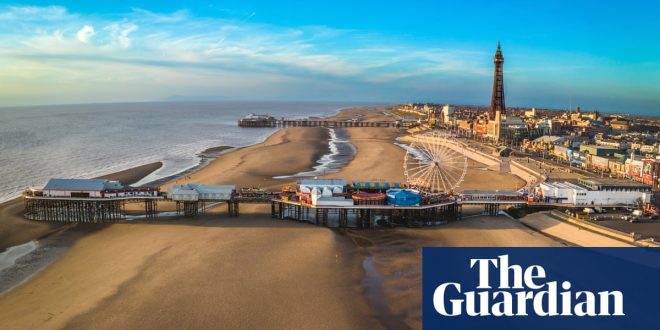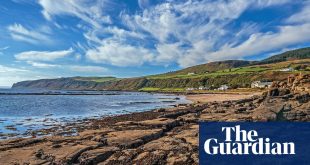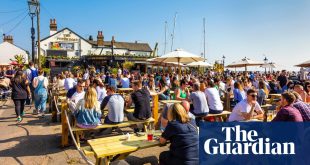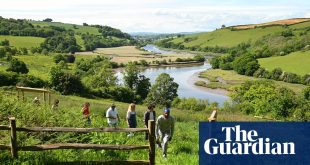It’s Showtown: Blackpool’s new ‘museum of fun’
I love walking in Blackpool. The stroll along the prom takes time and a bit of effort – it’s almost three miles from the South Shore to the Grand Hotel – and takes me past three piers and more than a century of architecture including Victorian, art deco, modern and postwar municipal. In her 2023 novel Pleasure Beach, Helen Palmer pastiches Joyce’s Ulysses: her home town perfectly suits its promiscuous, genre-hopping, list-loving energy. The expanses of sand, big skies and far horizons of the Irish Sea always distract and calm the soul.
A block inland, the picture gets complicated. There’s a lot more shabby than chic and the heritage landmarks – the tower complex, Winter Gardens and Grand theatre – are broken up by mainly rundown guesthouses and a general air of work in (slow) progress.
It’s not easy to make sense of Blackpool. It has always been good for amusements, rides, comedy and clubbing, but perhaps lacking in cultural or arts assets. In unseasonable weather – not rare on the Irish Sea coast – there weren’t many places to go during the day, unless you were a slot-machine or bingo fiend.
That has now all changed. In March, Showtown, a “museum of fun and entertainment”, opened close to Blackpool Tower. Its six galleries each explore themes that played a part in making Blackpool the UK’s most popular resort: seaside, magic, circus, illuminations, shows and dance. Museum design firm Casson Mann, working with council researchers and illustrator Alex Williamson, has created spaces that are bright, interactive and rich in historical detail. Jobs such as ringmaster, oyster seller and fortune teller are celebrated; cabinets display items kids played with before video games and smartphones, from itching powder to laugh bags to X-ray specs; and the use and abuse of donkeys and circus animals is not ignored. There are opportunities to have your photo taken and become part of the displays – this popular, democratic touch is very Blackpool.
Blackpool council’s own collections have been strengthened by loans from the V&A and sequined dresses and see-through shirts from the Strictly Come Dancing wardrobe. Original puppets, posters, stage props, vintage programmes, disco booths and clown costumes are presented alongside Williamson’s vivacious collages to relate stories about seaside history that will be familiar to people of a certain age but somewhat exotic for younger visitors.
The latter may wonder why Sooty and Sweep and old photographs of cars queueing to see the lights induce deep pangs of nostalgia in their parents and grandparents. Then again, whoopie cushions and severed fingers are timeless and ventriloquist dummies eternally terrifying. My memory was jogged at every turn: Orville the Duck, Tommy Cooper’s fez, Joe Loss, beauty contests. The colour scheme verges on the garish: you can almost taste the yellows and pinks and lurid greens – sugary and unashamedly artificial, like sticks of rock.
Showtown will host temporary exhibitions: the first, which opened earlier this month, is by photographer Andy Hollingworth, subtitled “I photograph comedians.” Hollingworth has worked with celebrated funny people including Rowan Atkinson, Steve Martin, Rik Mayall and Victoria Wood. The 50 images – some formal portraits, others off-stage moments of contemplation – were taken over 30 years and are presented alongside comedy memorabilia and a Laurel and Hardy documentary, The Last Dance of the Cuckoos – referencing Hollingworth’s love of Stan and Ollie.
Blackpool is often in the news for non-fun reasons: deprivation, homelessness, drug use. Let’s hope Showtown shines light on the paradox of being the UK’s most-visited seaside resort yet one of its poorest towns. Blackpool’s evolution as a tolerant, trad-with-a-twist, proudly working-class destination has its origins partly in town planning (or lack of it) but also in the culture of Romany Gypsies and the spontaneous summer pop-up stalls and entertainments that gave rise to the original Pleasure Beach towards the end of the 19th century. Showtown can dig deep and tell that story too. The town has plenty of heritage and history scattered all around; now it has a top-notch space in which to explore and honour it.
Adult £15, 4-15 years £11.50; showtownblackpool.co.uk
Chris Moss
Boat trips and birdwatching
Home to an estimated 200,000 seabirds, the Farne Islands, off the coast of Northumberland, were hit hard by avian flu in 2022, and the National Trust had to suspend visitor boat landings. Following a recovery in the bird population, restrictions have been lifted on the largest isle, Inner Farne, for this summer, which means boat passengers will be able to step ashore for the first time in two years for close encounters with puffins, arctic terns, eider ducks and kittiwakes. Visitors will also be able to get closer to the cultural history of the island, which has links with early Christianity and Saint Cuthbert, with access inside the beautiful St Cuthbert’s Chapel and exterior views of the Inner Farne lighthouse and Pele Tower. Boat trips depart from Seahouses (adult £30, child £23, under-fives free; additional landing fees of £13 adult, £6.50 child are payable to the National Trust).
Snorkel trails
Forget the Great Barrier Reef, Scotland has scores of snorkel trails showcasing its diverse sea life, from sea squirts, sponges and anemones to dolphins, basking sharks and whales. There are trails around the mainland coast, plus the isles of Arran and Harris (scottishwildlifetrust.org.uk). Most are self-guided, but on some trails you can book guided taster sessions.
This summer, there are six new sites to explore along the South Ayrshire coast, from Ballantrae to Troon. Snorkel in bays overlooked by ruined castles, around skerries (small, rocky islands) and through ancient sea caves – all watched over by Ailsa Craig, an extinct volcano that is home to Britain’s third-biggest seabird colony. Snorkellers walk across lava platforms, now full of rock pools, to reach the sandy beaches. In the sea, treasures include yellow periwinkle snails and semi-precious stones such as jasper and amethyst, as well as seals, otters and porpoises. Just remember to pack a wetsuit rather than a bikini.
In Devon, the National Marine Aquarium in Plymouth will be running snorkelling sessions for children and beginners through the summer. The city has won national lottery funding to develop the UK’s first national marine park and has an ambitious programme to improve wildlife habitats in the Plymouth Sound. “Sensory friendly” and beginners’ sessions will take place in sheltered rock pools, and snorkel safaris for over-12s and confident swimmers will venture out into the coast’s kelp meadows. Sessions cost from £18pp.
Kent’s new foodie hotspot: Deal
Darren Jenkins is arguably the most renowned fishmonger on the Kent coast, so much so that “people come down from London just to buy our fish”, says his partner in life and work, Sacha Taylor. The pair run Jenkins & Son, originally set up by Jenkins’s great-grandfather Charlie in the 1940s. “There were massive food shortages, but fish wasn’t rationed,” he says. “So he got a horse and cart, went down to Folkestone and started selling fish around houses in Dover, before setting up a small shack.”
In the 1970s, Jenkins senior and his son established a shop that would occupy the same spot on Deal High Street for half a century. Darren joined the business after leaving school in 1997 and is now expanding it with a new venture a few doors down. Its spacious interior has a wet fish counter on the right and a licensed area seating 24 on the left. With no bookings, customers queue for a table and order from a menu of what Jenkins terms “street food” but, on the evidence of the plates I order, is more elevated, thanks to head chef Peter Keyes.
Juicy king prawns are drizzled with salsa verde, a fish bun is packed with crisp-skinned bass, crushed peas and capers, while cod tacos come with fiery slaw and silken avocado. Next, the team plan to turn the disused first floor into a restaurant with terrace.
This is the latest in a run of new restaurants in this small seaside town on the east Kent coast. On the seafront, with its long shingle beach and brutalist 1950s pier, is the Blue Pelican, an elegant new dining room from the owners of acclaimed boutique hotel the Rose. I sit at the counter overlooking the open kitchen and chat to head chef Luke Jeffery-Green, who lived in Japan with his wife before moving back to Deal. He calls his cooking “classic Japanese” but adds: “Whenever I’m recreating dishes, other things come into play – such as local ingredients – so they turn into something unique.” He’s not wrong. The lunchtime bento box-style set menu (£23) includes a tastebud-tickling plate of pickles, mushroom broth, deep-fried aubergine agedashi and charred leek hearts. Equally compelling are oozy crab croquettes, and blistered prawns in beef fat butter.
Another newcomer is Cherub’s on the first floor of seafront pub Bohemian, where chef Jakob Grant (ex-Bouchon Racine) creates seasonal menus which showcase produce from local suppliers such as award-winning Deal butcher the Black Pig, and greengrocer Lavender and Blackberry.
A 10-minute drive inland is Updown Farmhouse, Ruth Leigh and Oliver Brown’s restaurant-with-rooms in a bucolic former farmstead which opened two years ago and recently earned a listing in the Michelin Guide.
And let’s not forget gamechanger Frog and Scot, a contemporary French bistro that opened in 2016. Now focusing more on small plates, it’s still on top of its game, as evidenced by dishes such as tomato carpaccio, courgette ribbons with pistachio and mint, and a must-try trout tartare in ponzu with kohlrabi and cherries.
Stephen Emms
The writer travelled to Deal from London on Southeastern, return tickets from £40.90
after newsletter promotion
Maritime festivals
The Isles of Scilly will celebrate their nautical heritage and marine environment with a new festival this August. The fortunes of this archipelago off the Cornish coast have long been tied to the sea and this will be the focus of the nine-day Ocean Scilly festival (23 Aug-1 Sep).
Visitors will be able to try activities including paddleboarding, kayaking, sailing, windsurfing, kitesurfing, coasteering and snorkelling with seals. There will also be workshops with seafarers; stories about shipwrecks and lighthouses, and events involving Scilly’s pilot gigs (seafaring rowing boats). The finale will see Swimrun events, from a taster session and a kids’ race to a challenging multi-island contest involving five miles of open-water swimming and 18 miles of trail running. Spectators are as welcome as athletes at the after-party.
In Lancashire, the Morecambe Maritime festival on 24 August will celebrate the town’s seafaring and fishing heritage with a day of sea shanty performances and events on the prom to raise funds for the Royal National Lifeboat Institution on its 200th anniversary. The RNLI website has details of other fundraising events taking place around the coastline, from concerts to kayak races, fish suppers to swimathons.
Cycle the coast
Somerset’s new coastal cycle route, the 13-mile Pier to Pier Way, opened earlier this month, connecting the Grand Pier in Weston-super-Mare with Clevedon Pier, which John Betjeman called the most beautiful in England. It forms the central section of the North Somerset Coastal Towns cycle route, which will eventually run from Brean, just north of Burnham-on-Sea, up to Portishead. The route sticks to quiet country roads and has several short traffic-free sections, including the Tutshill greenway, a former railway line. At Kewstoke, there’s an optional diversion to the Sand Point headland, which juts into the Bristol Channel. There are bird observation points en route and great views. At journey’s end cyclists can reward themselves with fish and chips at the Glass Box restaurant on Clevedon pier.
In Yorkshire, cyclists can take their pick from a selection of coastal trails that launched earlier this year, ranging from a nine-mile loop around Filey to a five-day point-to-point route between Whitby and Spurn Point. The trails were devised by Route YC along with a team of adventure cyclists, and include detailed guides, maps and suggestions for places to eat and stay.
Seaside art festivals
North Berwick will host Fringe by the Sea from 2–11 August, a laid-back alternative to the nearby Edinburgh festival with music, comedy, family events and talks taking place around this attractive East Lothian seaside town. Highlights will include the Jacksons performing some of their greatest hits, a DJ set from Hot Chip and a Rotten Royals show from the Horrible Histories crew.
On the south coast, Bournemouth will wrap up the summer with its annual Arts by the Sea festival (27-29 September), which is expanding into neighbouring Poole and Christchurch. Expect dazzling light installations, interactive sculptures, dance, street theatre and circus acts.
Beach saunas
Our love affair with Nordic-style beach saunas shows no sign of cooling off, with hot boxes popping up on beaches around the UK. The latest is in Northumberland, overlooking the magnificent sands at Newbiggin-by-the-Sea. The owners of the Cafe Needles Eye, which opened in a converted shipping container on the beach in May, are planning to launch a Himalayan salt sauna with a sea view – the perfect place to warm up after a dip in the North Sea. At the other end of the country, Southsea Beach Cafe in Hampshire has opened a seafront sauna offering one-hour sessions with views across the beach to South Parade Pier.
Across the Solent, DJ Rob da Bank continues his one-man mission to turn the Isle of Wight into the UK’s sauna capital. The National Trust-owned headland at Compton Bay is the current location for a traditional Lithuanian woodfired sauna, run by Rob and his wife Josie’s Slomo wellness brand, but the co-founder of Camp Bestival is aiming for a “sauna on every corner of the island”.
In Dorset, the Finnish-style Saltwater Sauna has been a popular addition to the beach at Sandbanks in Poole since it opened three years ago, and its owners have plans for two further saunas at Avon beach near Christchurch, expected to open in autumn. Dorset-based adventure company Land & Wave recently launched an SUP and Sauna package combining two hours of paddleboarding in Sandbanks or Studland with a one-hour sauna session.
Coastal feasting and foraging
On returning to the UK after travelling the world with their young family, Ali and Ian Paice decided to look for an escape from London. They found it on the Llŷn peninsula, where they bought an old farm and transformed it into Bert’s Kitchen Garden, a back-to-nature campsite and eco-retreat with tent pitches mown from wildflower meadows. New for this summer is Beachside, a cafe in a stylishly converted container on Trefor beach, serving cakes, cocktails, pizzas, steaks and sharing plates, with occasional supper club events. There’s a woodburner, perfect for warming up after a dip, and views of the distant peaks of Eryri (Snowdonia).
In Pembrokeshire, the Really Wild Restaurant in St David’s has won accolades for its tasting menus and small plates featuring locally foraged ingredients such as seaweed, berries and leaves. This summer families can sign up for one of its 90-minute Seashore Forage sessions which give an introduction to the plants and creatures that live in the rock pools around Whitesands beach (£40pp).
Walk the King Charles III England Coast Path
When complete, the King Charles III national trail will be the world’s longest managed coastal path, at 2,700 miles, and the first time the public has had the right to walk the entire English coastline. As new sections open, they are added to the map on the National Trails and Gov.uk websites. The latest stretch links Hunstanton in Norfolk, on the east of the Wash, to Sutton Bridge, on the River Nene in Lincolnshire.
This relatively remote stretch is perfect for birdwatching, with opportunities to spot ringed plovers and oystercatchers nesting on the sands at Hunstanton, Heacham and Shepherd’s Port. After Heacham, the path passes the rewilded Wild Ken Hill estate on its way to RSPB Snettisham. Here, lucky visitors might witness the “whirling wader spectacular”, where birds feed on the mudflats and then form murmurations as the tide rises.
Other new sections will include Silverdale to Cleveleys in Lancashire; Birkenhead, Merseyside, to the Welsh border; and stretches of the coast between Bawdsey in Suffolk and Jaywick in Essex.
 Top Naija News – Nigeria News, Nigerian News & Top Stories Top Naija News – Nigerian Newspapers, Nigerian News. topnaijanews is a daily Nigerian newspaper covering Latest News, Breaking News, Entertainment, Sports, Lifestyle and Politics.
Top Naija News – Nigeria News, Nigerian News & Top Stories Top Naija News – Nigerian Newspapers, Nigerian News. topnaijanews is a daily Nigerian newspaper covering Latest News, Breaking News, Entertainment, Sports, Lifestyle and Politics.




